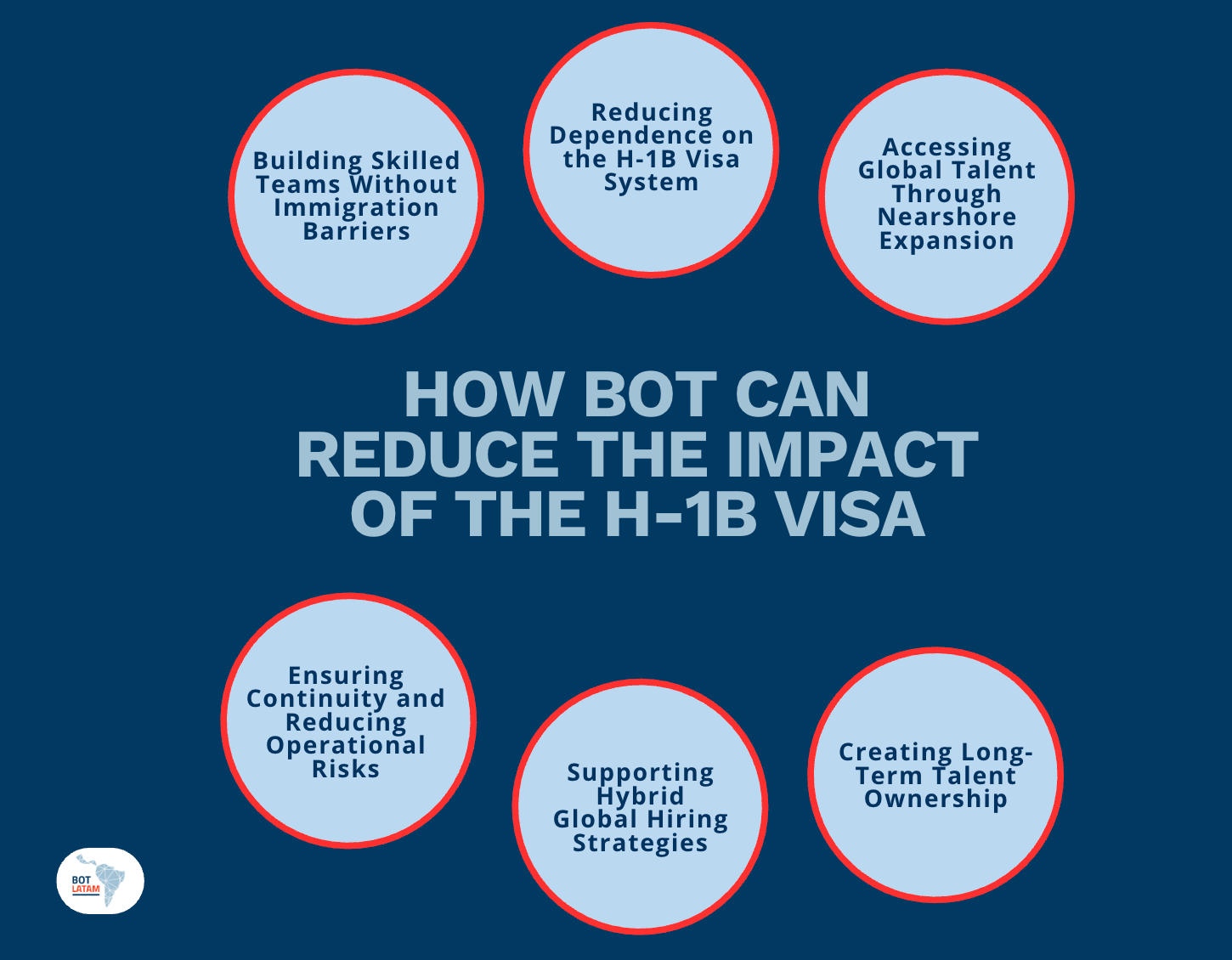The H-1B visa has long been a gateway for U.S. companies to access global tech talent. But as regulations tighten and demand keeps rising, that path is becoming increasingly narrow. In 2024 alone, over 780,000 H-1B registrations were submitted for just 85,000 slots, a record-high lottery ratio that left thousands of skilled professionals and employers without options, according to USCIS). Now factor in the recent fees and you’re left with a clear question: how can you access world-class talent without being bound by visa restrictions?
That’s where the Build-Operate-Transfer (BOT) nearshore model comes in. This approach lets you establish and manage teams abroad, especially in Latin America, while maintaining control, continuity, and scalability.
In this article, you’ll explore how the BOT model can reduce the impact of H-1B visa challenges, unlock Latin American talent pools, and provide a sustainable alternative to traditional global hiring models.
Understanding the H-1B Visa and Its Global Impact
The H-1B visa was designed to let U.S. companies hire highly skilled foreign professionals in specialized fields such as technology, engineering, and finance. For decades, it served as a bridge between global expertise and U.S. innovation. But over time, it’s also become a bottleneck, especially for companies competing for scarce technical talent.
According to U.S. Citizenship and Immigration Services, there were 780,884 H-1B registrations in fiscal year 2024, with only 85,000 visas available under the annual cap. That means fewer than 11% of applicants secured approval. This massive gap reflects both the global demand for U.S.-based jobs and the limited access employers have to international talent through the current system.
From a business perspective, that shortage hits hard. Many firms find themselves unable to fill critical positions, delaying projects or scaling back innovation. Tech companies are particularly exposed: in 2023, nearly 70% of H-1B applications were linked to roles in computer-related occupations, according to USCIS data.
The H-1B system also affects global workforce mobility. When highly qualified professionals can’t relocate to the U.S., companies must rethink how to integrate global talent without depending on physical relocation. This dynamic has encouraged a broader shift toward remote teams, nearshore hubs, and alternative hiring models, strategies that maintain access to top talent while avoiding visa limitations.
In short, the H-1B visa remains vital but increasingly restrictive. For companies competing in fast-moving sectors like software development, data engineering, and AI, relying solely on it poses operational and strategic risks. Understanding its impact isn’t just about compliance, it’s about adapting to a global hiring landscape where flexibility, proximity, and local partnerships are becoming far more valuable than visa sponsorships.
How BOT Can Reduce the Impact of the H-1B Visa

Building Skilled Teams Without Immigration Barriers.
The Build-Operate-Transfer (BOT) model removes the dependency on U.S. immigration systems by letting you establish nearshore operations in countries with strong technical talent. Instead of relocating employees under the H-1B visa, you create a self-sustaining team abroad that mirrors your internal structure.
A BOT setup typically starts with a partner helping you recruit, manage, and operate your offshore unit. Once it’s mature, the operation is transferred entirely to your control. This model allows you to maintain ownership, direction, and data security, without dealing with the unpredictability of visa lotteries or sponsorship limits.
Reducing Dependence on the H-1B Visa System.
Each year, tens of thousands of qualified candidates are denied entry to the U.S. workforce due to the H-1B cap. For employers, that means critical roles go unfilled and project timelines stretch out. The BOT structure offers a clear path forward by building those roles offshore instead of importing them.
This shift doesn’t just solve the visa bottleneck, it also improves business continuity. Teams remain intact, even as immigration rules fluctuate. Companies gain predictable hiring cycles and avoid the high costs of legal processing, relocation, and compliance tied to the H-1B process.
Accessing Global Talent Through Nearshore Expansion.
The BOT model gives you direct access to fast-growing talent markets in Latin America, where software development and engineering skills are abundant. According to the Stack Overflow Developer Survey, countries like Colombia, and Brazil have each seen double-digit growth in active developers since 2020.
This nearshore proximity provides an advantage that offshore regions can’t match: shared time zones, cultural alignment, and real-time collaboration with U.S. teams. As a result, companies using BOT structures in LATAM can scale more effectively and maintain productivity without the logistical challenges of distant outsourcing.
Ensuring Continuity and Reducing Operational Risks.
Projects tied to visa renewals often face disruptions when employees must leave the country or wait for approvals. The BOT model solves that by creating permanent, locally based teams that don’t rely on immigration cycles.
This approach stabilizes delivery timelines and minimizes risk across operations. You keep critical functions, from software development to cybersecurity, running consistently. Over time, that stability compounds into stronger internal capabilities and a more resilient organizational structure.
Supporting Hybrid Global Hiring Strategies.
As remote work becomes the norm, companies are rethinking how to build and retain global teams. The Deloitte Global Outsourcing Survey reports that 64% of executives now include nearshore or co-owned delivery centers in their workforce strategies. BOT fits perfectly into that trend, providing a hybrid structure that blends global reach with local control.
By integrating BOT into your hiring model, you can manage distributed teams, comply with local labor laws, and reduce dependency on any single jurisdiction. It’s a balanced strategy that aligns with modern workforce realities, flexible, scalable, and immune to H-1B constraints.
Creating Long-Term Talent Ownership.
Unlike traditional outsourcing, the BOT model is designed for the transfer of ownership. Once the operation is fully functional, it transitions to your organization’s control, including the team, infrastructure, and intellectual property.
That transfer phase transforms an external operation into an in-house extension. You gain long-term control of your workforce, protect proprietary assets, and build institutional knowledge. It’s not just a workaround for H-1B limits, it’s a foundation for lasting growth in an increasingly globalized talent market.
Why Companies Should Move Towards Ownership-Based Models
1. Building Long-Term Value Instead of Short-Term Contracts
Ownership-based models give companies something outsourcing rarely does, permanence. When you rely on external vendors, intellectual property and institutional knowledge often stay outside your control. By contrast, creating owned operations through models like Build-Operate-Transfer (BOT) ensures that every process, system, and innovation becomes a lasting business asset.
According to Deloitte’s Global Shared Services Survey, 72% of executives believe ownership of delivery centers directly improves operational resilience. Instead of cycling through temporary providers, you develop in-house expertise that compounds over time. This translates to faster onboarding, stronger internal alignment, and reduced dependency on third parties.
2. Enhancing Control Over Quality and Compliance
Regulatory environments and data protection laws are tightening globally. With an ownership-based model, you maintain direct oversight of compliance, infrastructure, and cybersecurity standards. That control is especially critical for companies handling sensitive data or operating in regulated industries.
Unlike traditional outsourcing, where visibility can be limited, owned entities allow for end-to-end quality governance. You decide on technology stacks, workflows, and compliance frameworks, minimizing risks associated with vendor management and ensuring alignment with corporate policies and industry standards.
3. Reducing Long-Term Costs Through Operational Efficiency
While setting up owned operations may seem cost-intensive initially, the long-term economics often outperform vendor-based contracts. Once the operation stabilizes, you eliminate markups and management fees charged by third-party providers.
Data from Everest Group shows that companies moving from outsourced to owned nearshore delivery centers achieve cost reductions of 20% to 35% over a three-year period. Savings stem from direct labor management, optimized resource allocation, and localized hiring strategies that reduce overhead.
4. Strengthening Talent Retention and Cultural Integration
In an ownership-based setup, employees are part of your company, not a contractor’s payroll. That difference matters. It builds stronger engagement, loyalty, and alignment with company culture and values.
The LinkedIn Global Talent Trends Report found that 79% of professionals are more likely to stay with an organization when they feel directly connected to its mission. By integrating your teams into an owned structure, you foster a sense of belonging and continuity that outsourced models can’t easily replicate.
5. Gaining Strategic Agility in Global Expansion
Owning your delivery centers provides flexibility to scale operations in line with business strategy rather than contract terms. When market conditions shift, you can reallocate resources, expand new service lines, or adjust structures without renegotiating agreements.
This autonomy allows for faster response times and more informed decision-making, both essential in competitive industries like tech, finance, and digital services. According to KPMG’s Global Business Services Outlook, organizations with owned nearshore centers report 25% faster time-to-market compared to those using third-party outsourcing.
6. Protecting Intellectual Property and Data Integrity
Ownership ensures that the systems, software, and knowledge your teams produce remain within your organization. With rising global concerns around cybersecurity, this level of control is no longer optional.
A report from IBM’s Cost of a Data Breach Study, estimated the average cost of a data breach at $4.88 million, emphasizing the financial and reputational risks tied to external dependencies. By keeping operations under your control, you reduce exposure to third-party vulnerabilities and safeguard proprietary technologies more effectively.
7. Creating Sustainable Global Workforce Structures
Ownership-based models align with the modern shift toward hybrid, distributed workforces. Instead of constantly rebuilding outsourced teams, you develop a sustainable global talent infrastructure that supports long-term innovation.
This approach lets you establish consistent standards across geographies while adapting to local labor conditions. Over time, the result is a globally connected, company-owned network of expertise that can outlast market volatility and regulatory changes, something traditional outsourcing rarely achieves.
Ready to Hire LATAM Talent Through BOT?
The growing limitations of the H-1B visa have forced companies to rethink how they access and retain global talent. Models like Build-Operate-Transfer (BOT) aren’t just workarounds, they’re strategic frameworks that let organizations expand with control, stability, and long-term ownership. In a global hiring market where demand outpaces supply, adaptability is now a competitive advantage.
At BOT LATAM, we specialize in helping companies establish and scale nearshore operations across Latin America through a structured BOT approach. Our model combines local expertise, legal compliance, and operational precision so you can build permanent, high-performing teams without relying on restrictive visa systems. With Latin America’s tech workforce growing consistently, the region offers both scalability and sustainability for companies aiming to future-proof their global talent strategies.
By partnering with us, you gain a transparent, ownership-driven pathway to expand your business while reducing visa-related dependencies, and moving toward a workforce model built for long-term growth. Contact us to learn more!

Revolutionize Your Workflow with Our Innovative BOT Strategy!
Enhance your operations seamlessly and adapt to market demands
Contact Us



